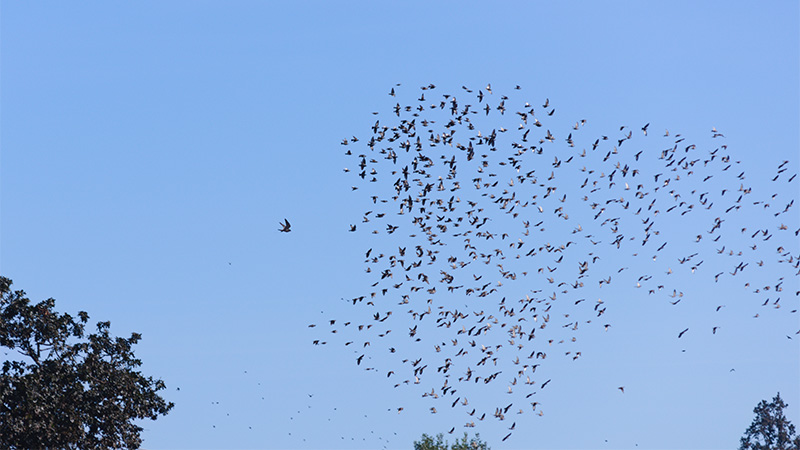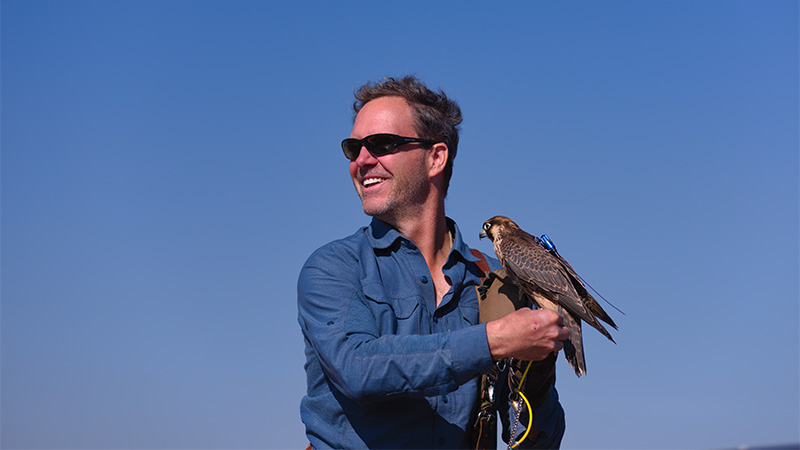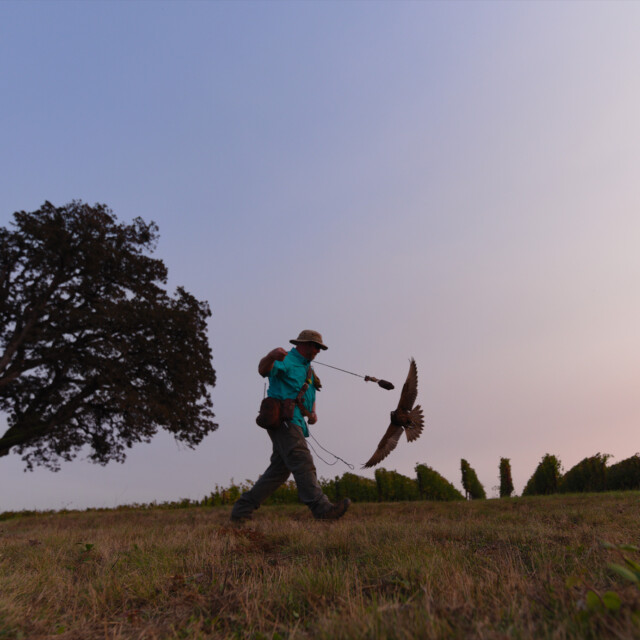Come fall in wine country, summer swarms of thirsty humans give way to hungry flocks of birds. Drawn to the near-ripe fruit of the season’s harvest, these vineyard pests descend on rows of Syrah, Pinot Gris, and Gamay Noir for a feast. As you might imagine, this drives winemakers bonkers. Wine grapes are expensive, hard to grow, and, well, the main ingredient in wine. A team of starlings can eat thousands of dollars worth of the crop in mere minutes.
Enter any number of bird-away protocols, from propane cannons and recorded hawk screeches played at full volume to netting, reflective ribbon, and even kites. Perhaps the best approach, though, is falconry, an age-old practice that involves releasing a trained bird of prey on the estate to terrify the winged nuisances.
Alina Blankenship started Sky Guardian Falconry, a company that targets nuisance birds, in 2021. In addition to contracting with vineyards, the company works with other agricultural sectors, businesses, marinas, sports stadiums, and airports to drive out unwanted wildlife. She admits that she got into the game late, not dabbling in falconry until she was nearly 40. “A friend of mine contacted me about a bird banging itself against a window in her garage,” she says. “I didn’t possess any special skills; I simply had more nerve than she. I trapped the bird in a coat and took it into a bathroom to see if it seemed okay.”

That was the beginning. Soon, Blankenship found herself researching Cooper’s Hawks, and she grew interested. She’s been a falconer now for 13 years.
Blakenship refers to her birds as “winged Dobermans.” Like the fearsome canine, they’re effective watchdogs; protectors of the vineyard. There are other options for keeping aerial pests at bay, some better than others, but as Blankenship says, they’re all essentially forms of mimicry. It often takes a real bird to keep the others away. And it helps to think like one, too.
“Birds see in the UV spectrum,” she says. “Where we see a starling as a black bird with iridescent highlights, they see an iridescent bird with some black, so a plastic owl is like asking you to believe a poodle is real if it’s pink.” In other words, good luck steering the swarms away with that hawk-shaped kite.
What of the cannon fire some vineyard crews employ? They may as well be dinner bells, she says. “When a cannon is deployed, it is momentarily frightening and annoying; however, not only does nothing bad happen, something good happens — it’s an indication that the fruit is ripe as that’s when they are called into service” says Blankenship.
A real bird of prey is a pretty effective form of intimidation. Anybody who’s seen a swarm of smaller birds flee the scene when a red-tailed hawk shows up knows as much. Falconers send their trained birds out on missions, actively chasing smaller birds out of the vineyard as if on the hunt. In fact, sometimes they’ll even catch their prey.

Kort Clayton got into falconry three decades ago while he was in college. He’s since molded it into a full-on career as the principal of Integrated Aviation Solutions, a bird management outfit based in Oregon’s Willamette Valley. He says the 2022 growing season was an involved one for his trade.
“For us, busy means ‘birdy,’” he says. “It’s years like this where the harvest runs deep into October; the grapes are vulnerable to hungry migrating flocks of cedar waxwings, starlings, and robins.”
In Oregon, harvest was delayed this season due to an especially cool and wet spring that stretched into bloom. Poor weather in May was cause for alarm, and some in the know suggested that crop loads might be cut in half. Fortunately, a fantastic October in terms of weather saved the vintage, although it did bring some added bird pressure.
“Falcons and falconers scouring every wine from sunrise to sunset, seven days a week,” he says of the harvest. “It’s intense, but we savor every minute of it.”
The gig has a place outside the vineyard, too. Blankenship says she worked with the Army Corps of Engineers on The Dalles Dam Project, wherein she had her birds scare the many resident gulls and cormorants away. These pesky birds feed on young salmon trying to make it to the ocean. She and Clayton are often hired to take on birds like crows, pigeons, and geese in venues like stadiums and recycling centers. But it’s the vineyard that feels the most romantic — a natural setting that makes many falcons and falconers feel most at home.
An estimated 4,000 falconers call the U.S. home. It’s a tiny group, rich with characters. And, like becoming a vintner or Master of Wine, earning the title does not just happen overnight. As Clayton says, it’s a real process. “Falconry is regulated at the state and federal levels,” he says. “Price of admission is months of independent study, passing a state-administered exam, and a two-year apprenticeship.”

He says there’s also a special-purpose permit needed from the U.S. Fish and Wildlife Service to provide pro-bird abatement services. Witnessing all that training put to work in the vineyard is quite the spectacle. Falconers and their birds have intimate relationships, and seeing the raptors come and go — from gauntlet (the name of a falconer’s protective glove) to darting run in the sky and back to gauntlet — is a thing of beauty. It also taps into something primal, not unlike wine itself. Both viticulture and falconry have been around for thousands of years, and it seems like the relationship between the two is healthy enough to last a few thousand more.
“Let’s face it, falconers are artists,” Clayton says. “So it naturally follows that our community is rich with passion, personality, emotion, and quirks.”
